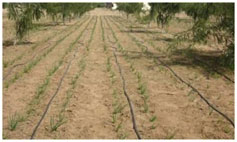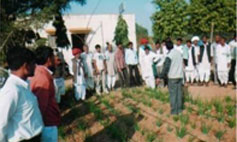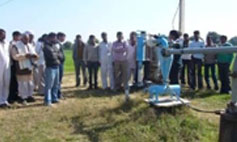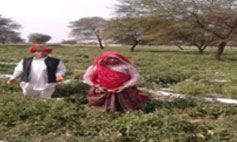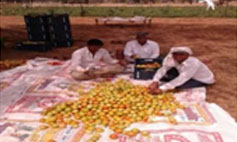Training Capacity / Building Activities
A Success of Public Private Partnership (Vegetable Production through Drip Irrigation)
Promoting Drip Irrigation in Vegetable Cultivation

Installation of Drip Irrigation System
| Year | No. of Farmers | Area Covered (ha) | Crops Grown |
|---|---|---|---|
| 2007-08 | 15 | 7.5 | Onion, Tomato, Chilli, Brinjal, Watermelon, Cauliflower |
| 2008-09 | 12 | 6.0 | Onion, Tomato, Chilli, Brinjal, Watermelon, Cauliflower |
| 2009-10 | 160 | 80 | Onion, Tomato, Chilli, Brinjal, Watermelon, Cauliflower |
| 2010-11 | 143 | 76.5 | Onion, Tomato, Chilli, Brinjal, Watermelon, Cauliflower |
| 2011-12 | 183 | 91.5 | Onion, Tomato, Chilli, Brinjal, Watermelon, Cauliflower |
| Total | 513 | 256.5 | Onion, Tomato, Chilli, Brinjal, Watermelon, Cauliflower |
Impact of Programme
- 65-70% water saving : Cultivable Area increase by 25-40%
- Labour and Input saving : Decrease in cost of production
- Quality produce : More and assured income
- Almost 150 villages are covered under this programme
- More than1200 farmers are joining this programme
Adoption of integrated disease management technologies had Improved the socio-economic status of vegetable growers
Introduction
A small farmers group of 10 families living in the Dhani Mithawa Ka Was, Village Singod Khurd with the joint families. The average holding of the group is 1.0 ha/family. They were cultivating the vegetables namely Onion, Tomato, Chilli and Watermelon since last six years, but they were not getting expected yield and profitability from these vegetables. Several diseases specially purple blotch and downey mildew of onion, collar rot, root rot, early blight and fruit rot of tomato, anthractnose of chilli and anthractnose and downey mildew of watermelon were caused the losses in the productivity of these vegetables. Farmers were tried on their level best and also taken the advice of local input supplies for the management of these diseases. Due to this, their overall cost on disease management was very high and their profitability was very less.
KVK Intervention
Three years back, that group come into the contact of Krishi Vigyan Kendra, Chomu (Jaipur). KVK has conducted on-farm- trials on onion (for thrips and purple blotch management) and tomato (management of early blight) and organized On/Off Campus training for the transfer of IDM Technologies to the group. Under these trainings, KVK has advised to them about the soil treatment with Trichoderama viride (3x10 7 cfu) @ 2.5 kg/ha after multiplication in well rotten FYM during Rainy and Rabi season and also given them proper schedule of fungicides application in a judicious manner.
We also advised them the use of surfactant @ 0.5 ml/liter of water with every spray solution. Resulting the root-rot and collar-rot diseases of Tomato and Chilli were managed and the losses due to foliar diseases in different vegetable crops were also minimized.
Output
Earlier their expenses on plant protection measures was Rs. 9,000/- to 10,000/- per ha. per year and now it remains only Rs. 6,000/- to Rs. 8,000/- per ha. per year. Earlier their average annual income was Rs. 1.75 to 2.0 Lacs per ha., from different vegetables which has been now increased and reached upto Rs. 3.50 to 4.00 Lacs per ha. per year.
Outcome
Now several other farmers of Village Singod, Khejroli and surrounding areas are taken the advice from that group about integrated disease management. Some of the members of that group are now popularizing the IDM Technologies in the area.
Impact
Earlier their income was not sufficient for family expenses. Now they are not only fulfilling the needs of their families but they are giving good education to their children.
Effect of azolla feed on milk productivity.
Introduction
The demand for milk and meat has been increasing. However there is a substantial decline in fodder production, owing to the decreasing area under forest and grasslands. The fodder availability from various crops has also decreased largely due to the introduction of high yielding dwarf varieties.
Azolla which holds the promise as a sustainable feed subssitute for livestock. Azolla is very rich in proteins, essential amino acids, vitamins (Vitamin A, Vitamin B12, Beta carotene) growth promoter and minerals like calcium, phosphorus. Potassium, ferrous, copper, magnesium etc. Azolla, on a dry weight basis, is constituted of 25-30% protein, 10-15% mineral and 7-10


